Detailed Analysis of Financial Statements and Performance Report
VerifiedAdded on 2022/12/30
|9
|1514
|34
Report
AI Summary
This report provides a detailed analysis of financial statements, including an income statement, balance sheet, and cash flow statement. The income statement presents the company's financial performance over a specific period, detailing revenue, expenses, and net income. The balance sheet offers a snapshot of the company's financial position at a given point in time, outlining assets, liabilities, and equity. The cash flow statement explains how the company obtains and spends cash through operating, investing, and financing activities. The report emphasizes the importance of each statement in understanding a company's financial health and performance, offering insights into profitability, liquidity, and overall financial stability. The financial statements are presented for the year 2020 and 2019 with different components like revenue, cost of goods sold, assets, liabilities, and equity with their respective values. The importance and components of each statement are also discussed.
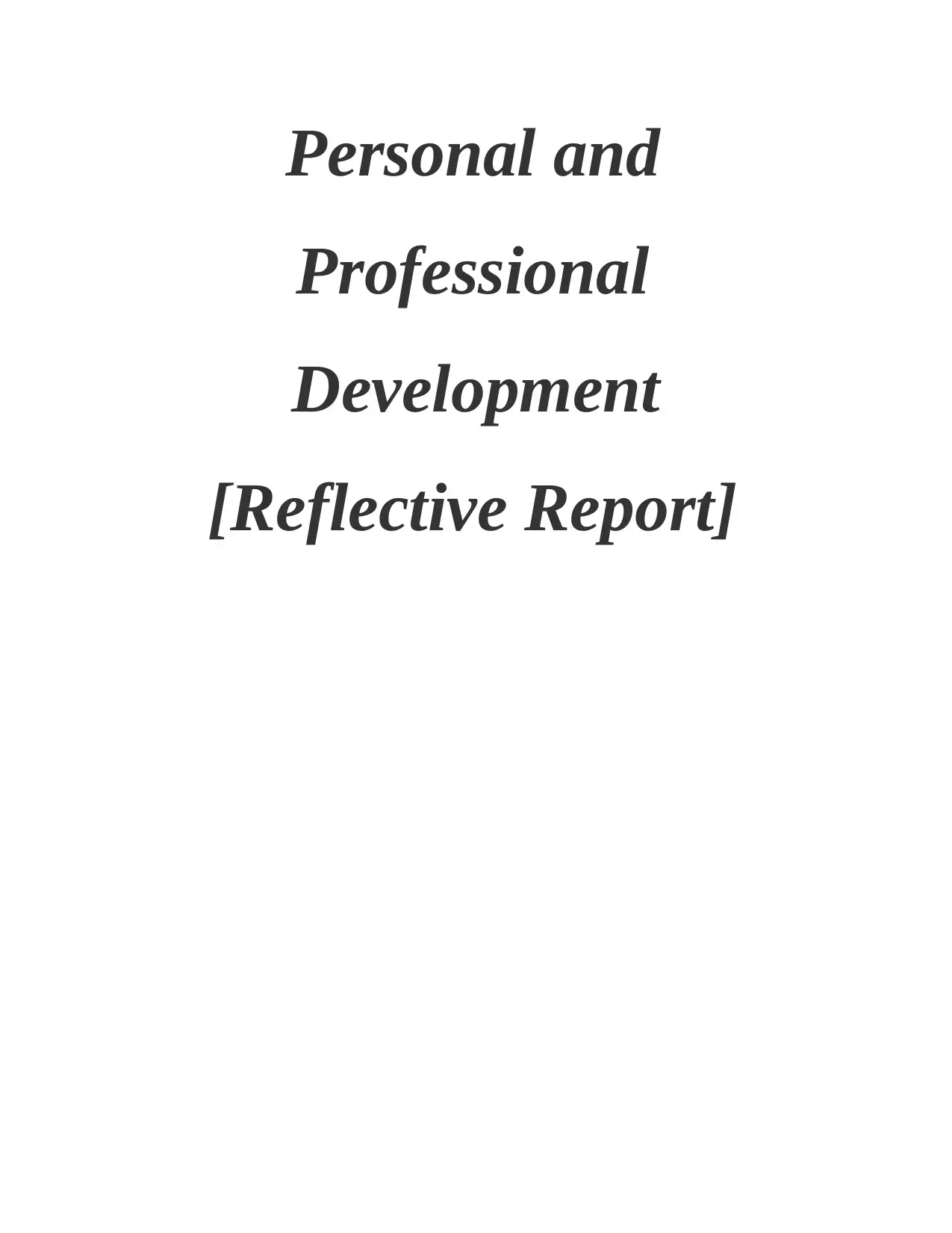
Personal and
Professional
Development
[Reflective Report]
Professional
Development
[Reflective Report]
Paraphrase This Document
Need a fresh take? Get an instant paraphrase of this document with our AI Paraphraser
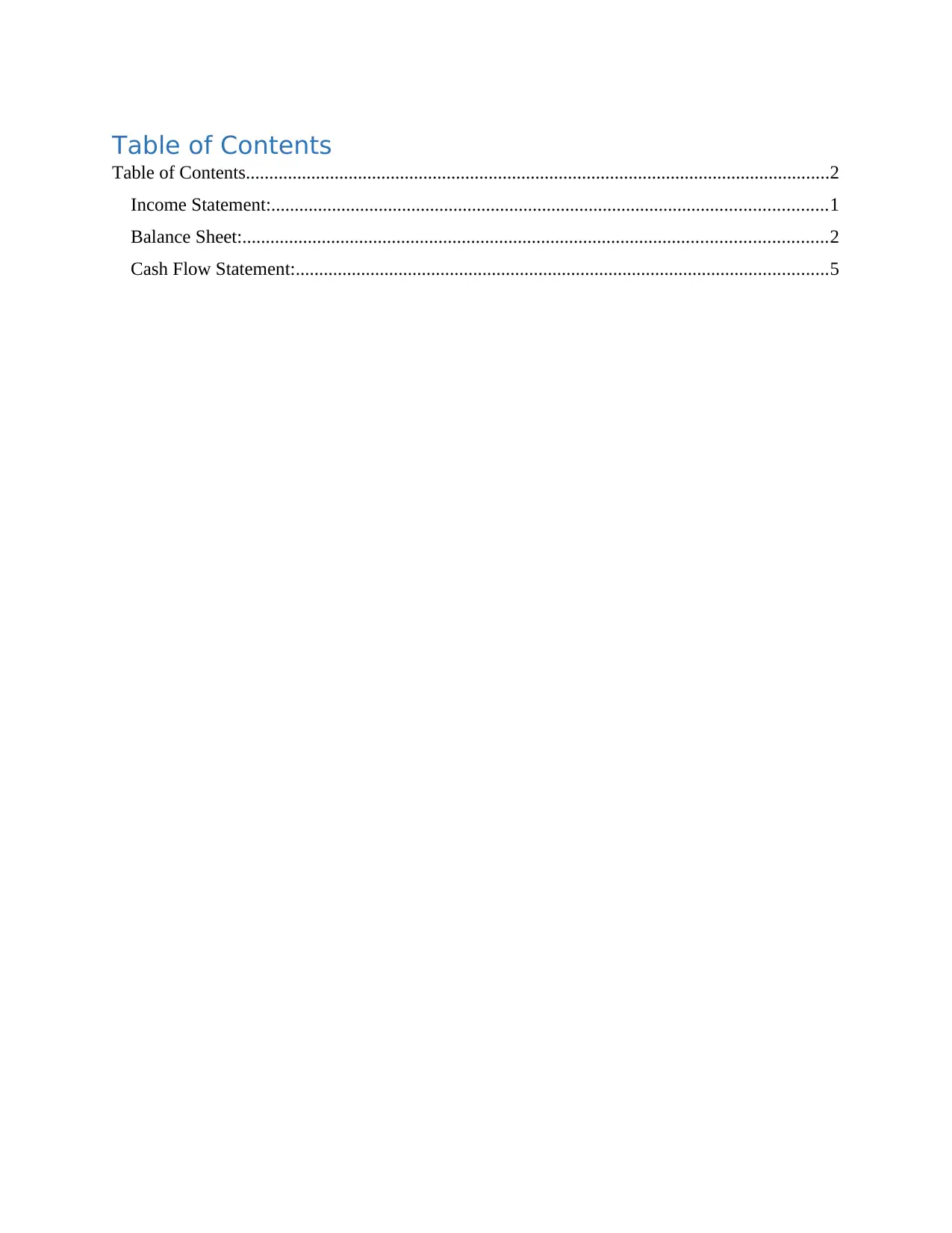
Table of Contents
Table of Contents.............................................................................................................................2
Income Statement:.......................................................................................................................1
Balance Sheet:.............................................................................................................................2
Cash Flow Statement:..................................................................................................................5
Table of Contents.............................................................................................................................2
Income Statement:.......................................................................................................................1
Balance Sheet:.............................................................................................................................2
Cash Flow Statement:..................................................................................................................5
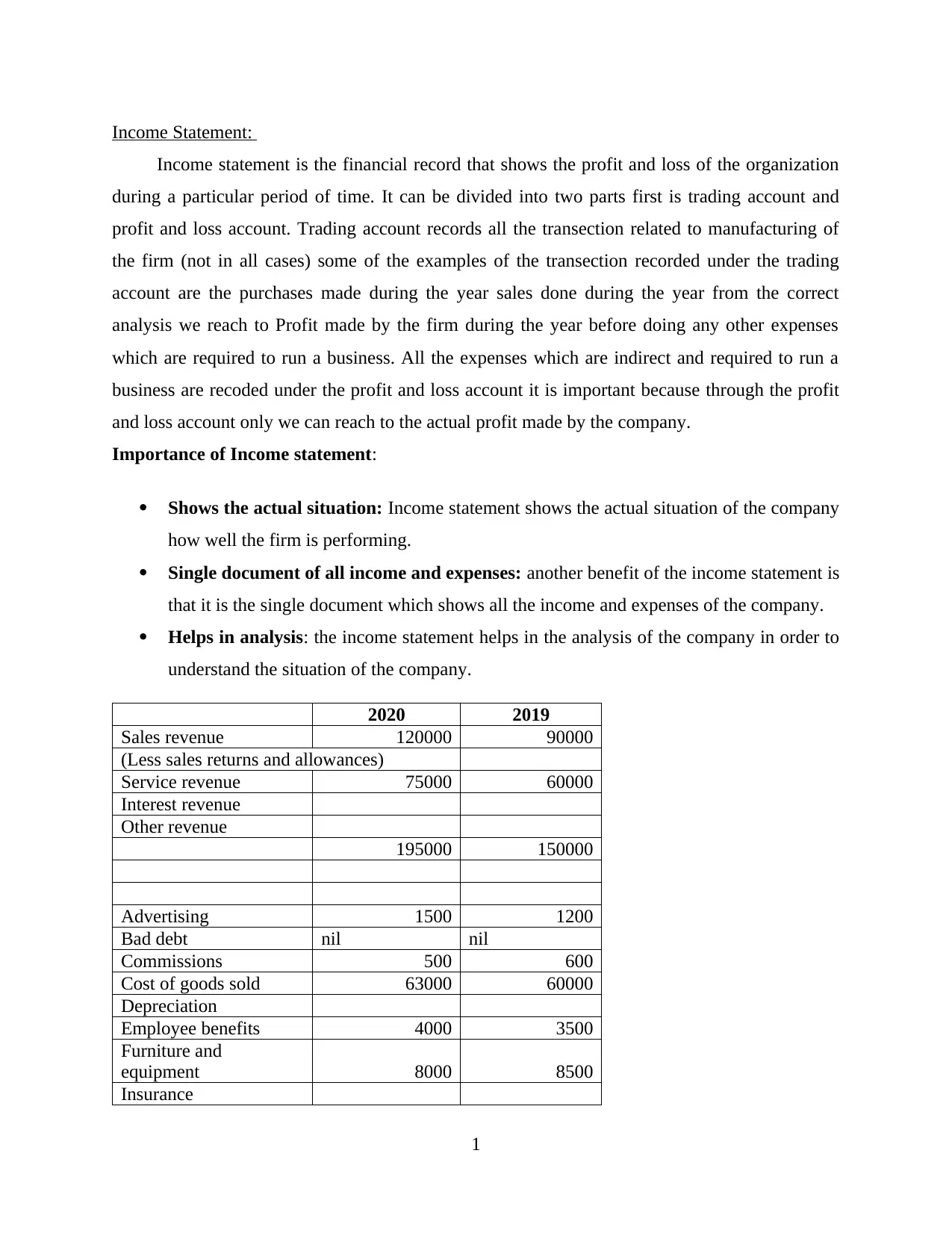
Income Statement:
Income statement is the financial record that shows the profit and loss of the organization
during a particular period of time. It can be divided into two parts first is trading account and
profit and loss account. Trading account records all the transection related to manufacturing of
the firm (not in all cases) some of the examples of the transection recorded under the trading
account are the purchases made during the year sales done during the year from the correct
analysis we reach to Profit made by the firm during the year before doing any other expenses
which are required to run a business. All the expenses which are indirect and required to run a
business are recoded under the profit and loss account it is important because through the profit
and loss account only we can reach to the actual profit made by the company.
Importance of Income statement:
Shows the actual situation: Income statement shows the actual situation of the company
how well the firm is performing.
Single document of all income and expenses: another benefit of the income statement is
that it is the single document which shows all the income and expenses of the company.
Helps in analysis: the income statement helps in the analysis of the company in order to
understand the situation of the company.
2020 2019
Sales revenue 120000 90000
(Less sales returns and allowances)
Service revenue 75000 60000
Interest revenue
Other revenue
195000 150000
Advertising 1500 1200
Bad debt nil nil
Commissions 500 600
Cost of goods sold 63000 60000
Depreciation
Employee benefits 4000 3500
Furniture and
equipment 8000 8500
Insurance
1
Income statement is the financial record that shows the profit and loss of the organization
during a particular period of time. It can be divided into two parts first is trading account and
profit and loss account. Trading account records all the transection related to manufacturing of
the firm (not in all cases) some of the examples of the transection recorded under the trading
account are the purchases made during the year sales done during the year from the correct
analysis we reach to Profit made by the firm during the year before doing any other expenses
which are required to run a business. All the expenses which are indirect and required to run a
business are recoded under the profit and loss account it is important because through the profit
and loss account only we can reach to the actual profit made by the company.
Importance of Income statement:
Shows the actual situation: Income statement shows the actual situation of the company
how well the firm is performing.
Single document of all income and expenses: another benefit of the income statement is
that it is the single document which shows all the income and expenses of the company.
Helps in analysis: the income statement helps in the analysis of the company in order to
understand the situation of the company.
2020 2019
Sales revenue 120000 90000
(Less sales returns and allowances)
Service revenue 75000 60000
Interest revenue
Other revenue
195000 150000
Advertising 1500 1200
Bad debt nil nil
Commissions 500 600
Cost of goods sold 63000 60000
Depreciation
Employee benefits 4000 3500
Furniture and
equipment 8000 8500
Insurance
1
⊘ This is a preview!⊘
Do you want full access?
Subscribe today to unlock all pages.

Trusted by 1+ million students worldwide
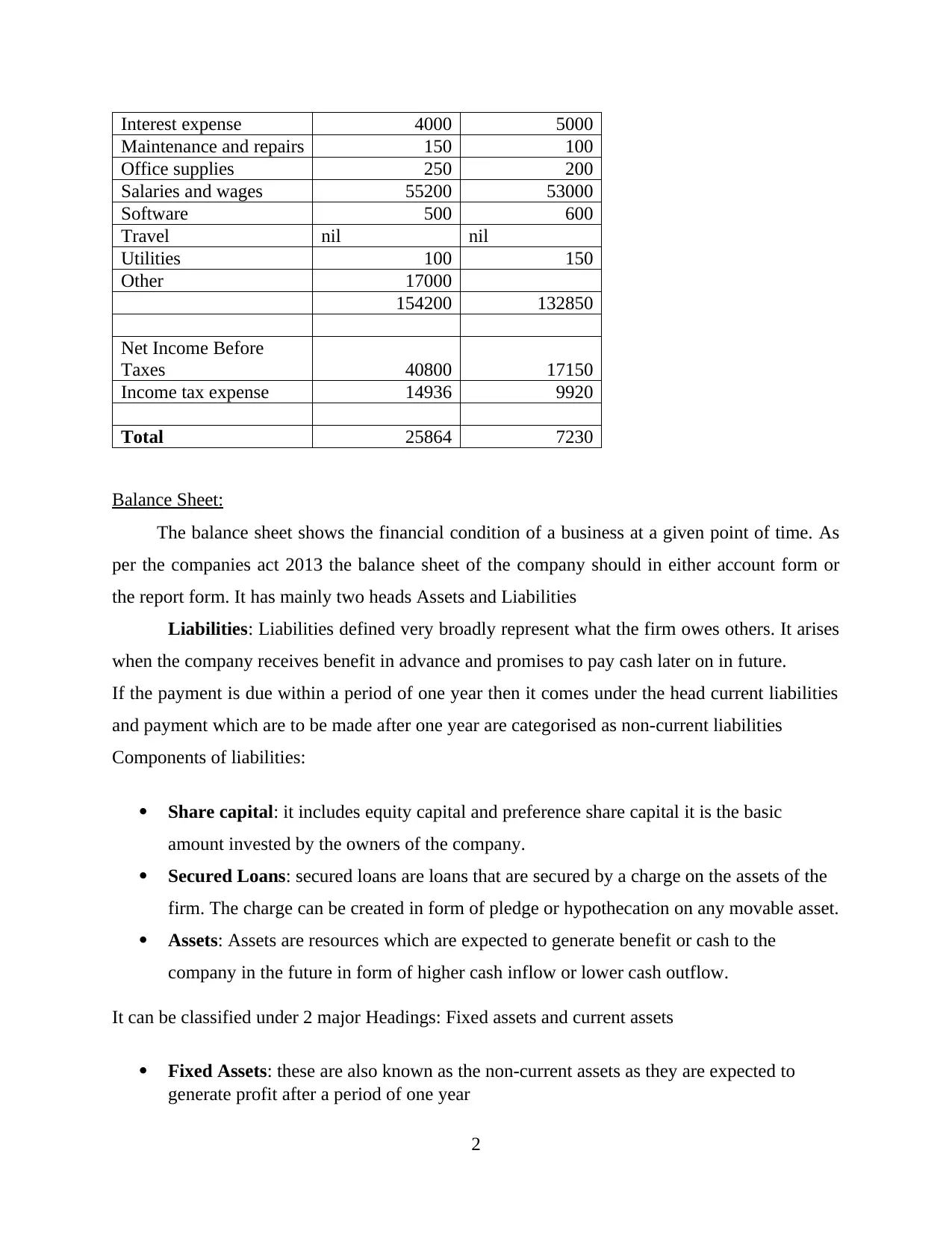
Interest expense 4000 5000
Maintenance and repairs 150 100
Office supplies 250 200
Salaries and wages 55200 53000
Software 500 600
Travel nil nil
Utilities 100 150
Other 17000
154200 132850
Net Income Before
Taxes 40800 17150
Income tax expense 14936 9920
Total 25864 7230
Balance Sheet:
The balance sheet shows the financial condition of a business at a given point of time. As
per the companies act 2013 the balance sheet of the company should in either account form or
the report form. It has mainly two heads Assets and Liabilities
Liabilities: Liabilities defined very broadly represent what the firm owes others. It arises
when the company receives benefit in advance and promises to pay cash later on in future.
If the payment is due within a period of one year then it comes under the head current liabilities
and payment which are to be made after one year are categorised as non-current liabilities
Components of liabilities:
Share capital: it includes equity capital and preference share capital it is the basic
amount invested by the owners of the company.
Secured Loans: secured loans are loans that are secured by a charge on the assets of the
firm. The charge can be created in form of pledge or hypothecation on any movable asset.
Assets: Assets are resources which are expected to generate benefit or cash to the
company in the future in form of higher cash inflow or lower cash outflow.
It can be classified under 2 major Headings: Fixed assets and current assets
Fixed Assets: these are also known as the non-current assets as they are expected to
generate profit after a period of one year
2
Maintenance and repairs 150 100
Office supplies 250 200
Salaries and wages 55200 53000
Software 500 600
Travel nil nil
Utilities 100 150
Other 17000
154200 132850
Net Income Before
Taxes 40800 17150
Income tax expense 14936 9920
Total 25864 7230
Balance Sheet:
The balance sheet shows the financial condition of a business at a given point of time. As
per the companies act 2013 the balance sheet of the company should in either account form or
the report form. It has mainly two heads Assets and Liabilities
Liabilities: Liabilities defined very broadly represent what the firm owes others. It arises
when the company receives benefit in advance and promises to pay cash later on in future.
If the payment is due within a period of one year then it comes under the head current liabilities
and payment which are to be made after one year are categorised as non-current liabilities
Components of liabilities:
Share capital: it includes equity capital and preference share capital it is the basic
amount invested by the owners of the company.
Secured Loans: secured loans are loans that are secured by a charge on the assets of the
firm. The charge can be created in form of pledge or hypothecation on any movable asset.
Assets: Assets are resources which are expected to generate benefit or cash to the
company in the future in form of higher cash inflow or lower cash outflow.
It can be classified under 2 major Headings: Fixed assets and current assets
Fixed Assets: these are also known as the non-current assets as they are expected to
generate profit after a period of one year
2
Paraphrase This Document
Need a fresh take? Get an instant paraphrase of this document with our AI Paraphraser
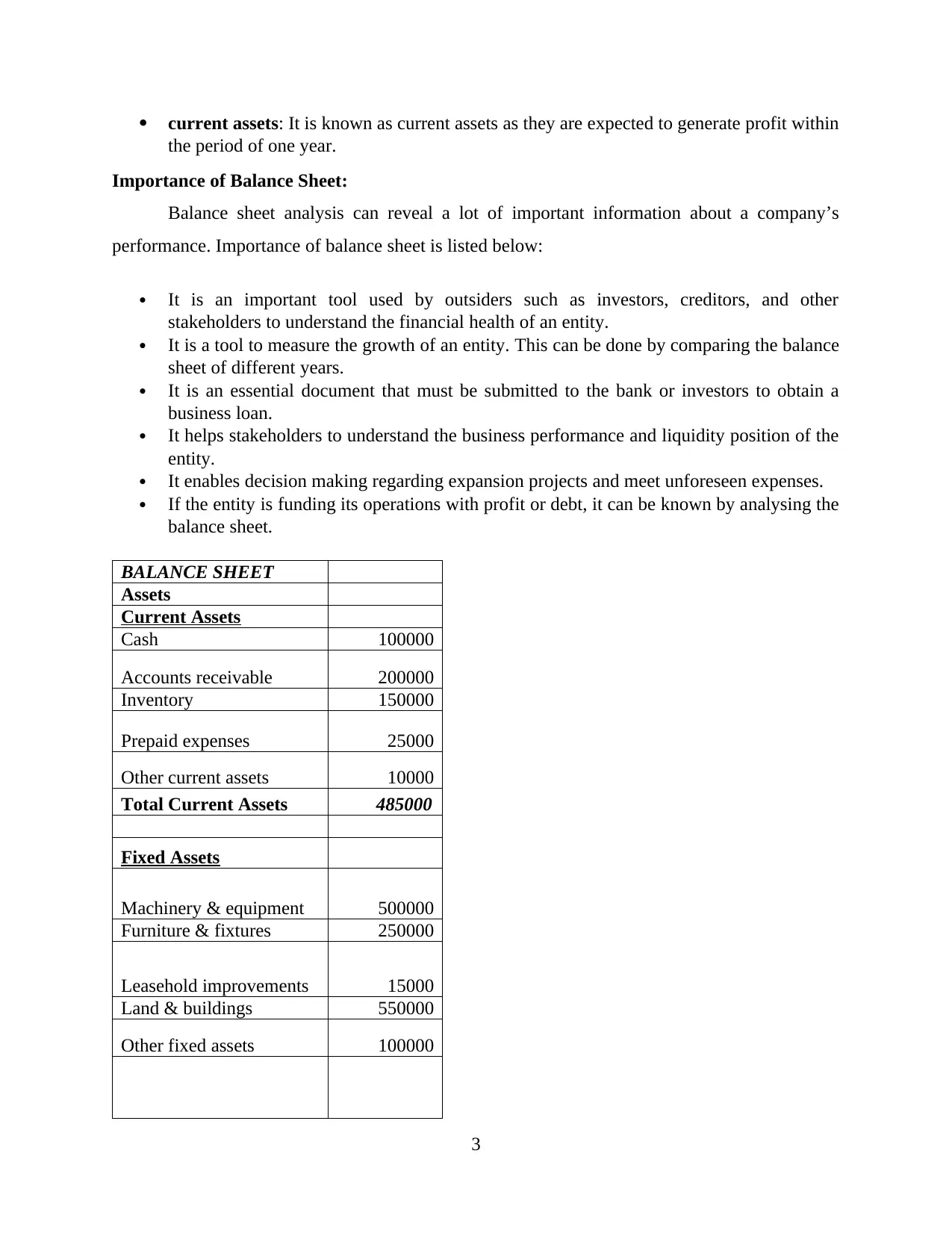
current assets: It is known as current assets as they are expected to generate profit within
the period of one year.
Importance of Balance Sheet:
Balance sheet analysis can reveal a lot of important information about a company’s
performance. Importance of balance sheet is listed below:
It is an important tool used by outsiders such as investors, creditors, and other
stakeholders to understand the financial health of an entity.
It is a tool to measure the growth of an entity. This can be done by comparing the balance
sheet of different years.
It is an essential document that must be submitted to the bank or investors to obtain a
business loan.
It helps stakeholders to understand the business performance and liquidity position of the
entity.
It enables decision making regarding expansion projects and meet unforeseen expenses.
If the entity is funding its operations with profit or debt, it can be known by analysing the
balance sheet.
BALANCE SHEET
Assets
Current Assets
Cash 100000
Accounts receivable 200000
Inventory 150000
Prepaid expenses 25000
Other current assets 10000
Total Current Assets 485000
Fixed Assets
Machinery & equipment 500000
Furniture & fixtures 250000
Leasehold improvements 15000
Land & buildings 550000
Other fixed assets 100000
3
the period of one year.
Importance of Balance Sheet:
Balance sheet analysis can reveal a lot of important information about a company’s
performance. Importance of balance sheet is listed below:
It is an important tool used by outsiders such as investors, creditors, and other
stakeholders to understand the financial health of an entity.
It is a tool to measure the growth of an entity. This can be done by comparing the balance
sheet of different years.
It is an essential document that must be submitted to the bank or investors to obtain a
business loan.
It helps stakeholders to understand the business performance and liquidity position of the
entity.
It enables decision making regarding expansion projects and meet unforeseen expenses.
If the entity is funding its operations with profit or debt, it can be known by analysing the
balance sheet.
BALANCE SHEET
Assets
Current Assets
Cash 100000
Accounts receivable 200000
Inventory 150000
Prepaid expenses 25000
Other current assets 10000
Total Current Assets 485000
Fixed Assets
Machinery & equipment 500000
Furniture & fixtures 250000
Leasehold improvements 15000
Land & buildings 550000
Other fixed assets 100000
3
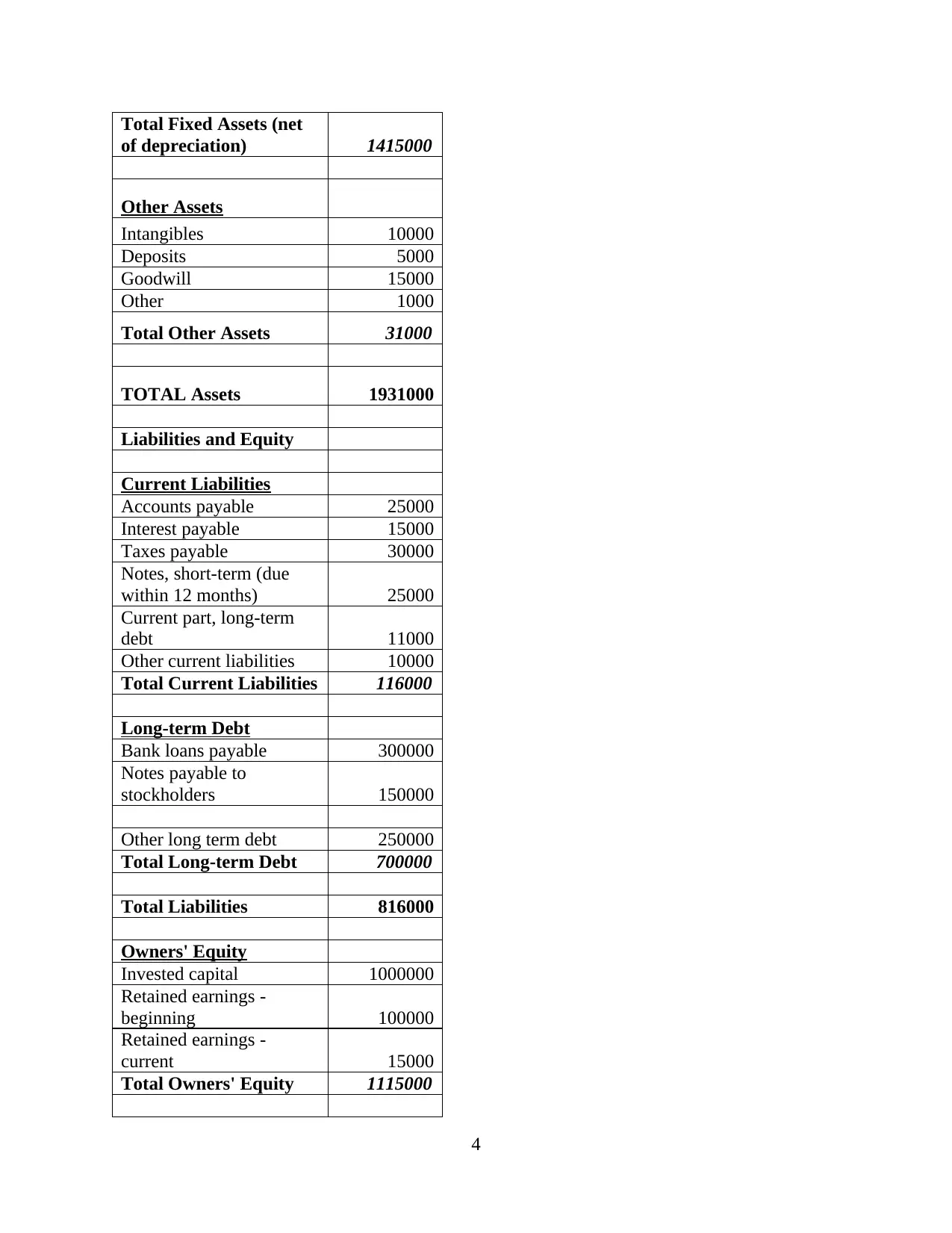
Total Fixed Assets (net
of depreciation) 1415000
Other Assets
Intangibles 10000
Deposits 5000
Goodwill 15000
Other 1000
Total Other Assets 31000
TOTAL Assets 1931000
Liabilities and Equity
Current Liabilities
Accounts payable 25000
Interest payable 15000
Taxes payable 30000
Notes, short-term (due
within 12 months) 25000
Current part, long-term
debt 11000
Other current liabilities 10000
Total Current Liabilities 116000
Long-term Debt
Bank loans payable 300000
Notes payable to
stockholders 150000
Other long term debt 250000
Total Long-term Debt 700000
Total Liabilities 816000
Owners' Equity
Invested capital 1000000
Retained earnings -
beginning 100000
Retained earnings -
current 15000
Total Owners' Equity 1115000
4
of depreciation) 1415000
Other Assets
Intangibles 10000
Deposits 5000
Goodwill 15000
Other 1000
Total Other Assets 31000
TOTAL Assets 1931000
Liabilities and Equity
Current Liabilities
Accounts payable 25000
Interest payable 15000
Taxes payable 30000
Notes, short-term (due
within 12 months) 25000
Current part, long-term
debt 11000
Other current liabilities 10000
Total Current Liabilities 116000
Long-term Debt
Bank loans payable 300000
Notes payable to
stockholders 150000
Other long term debt 250000
Total Long-term Debt 700000
Total Liabilities 816000
Owners' Equity
Invested capital 1000000
Retained earnings -
beginning 100000
Retained earnings -
current 15000
Total Owners' Equity 1115000
4
⊘ This is a preview!⊘
Do you want full access?
Subscribe today to unlock all pages.

Trusted by 1+ million students worldwide
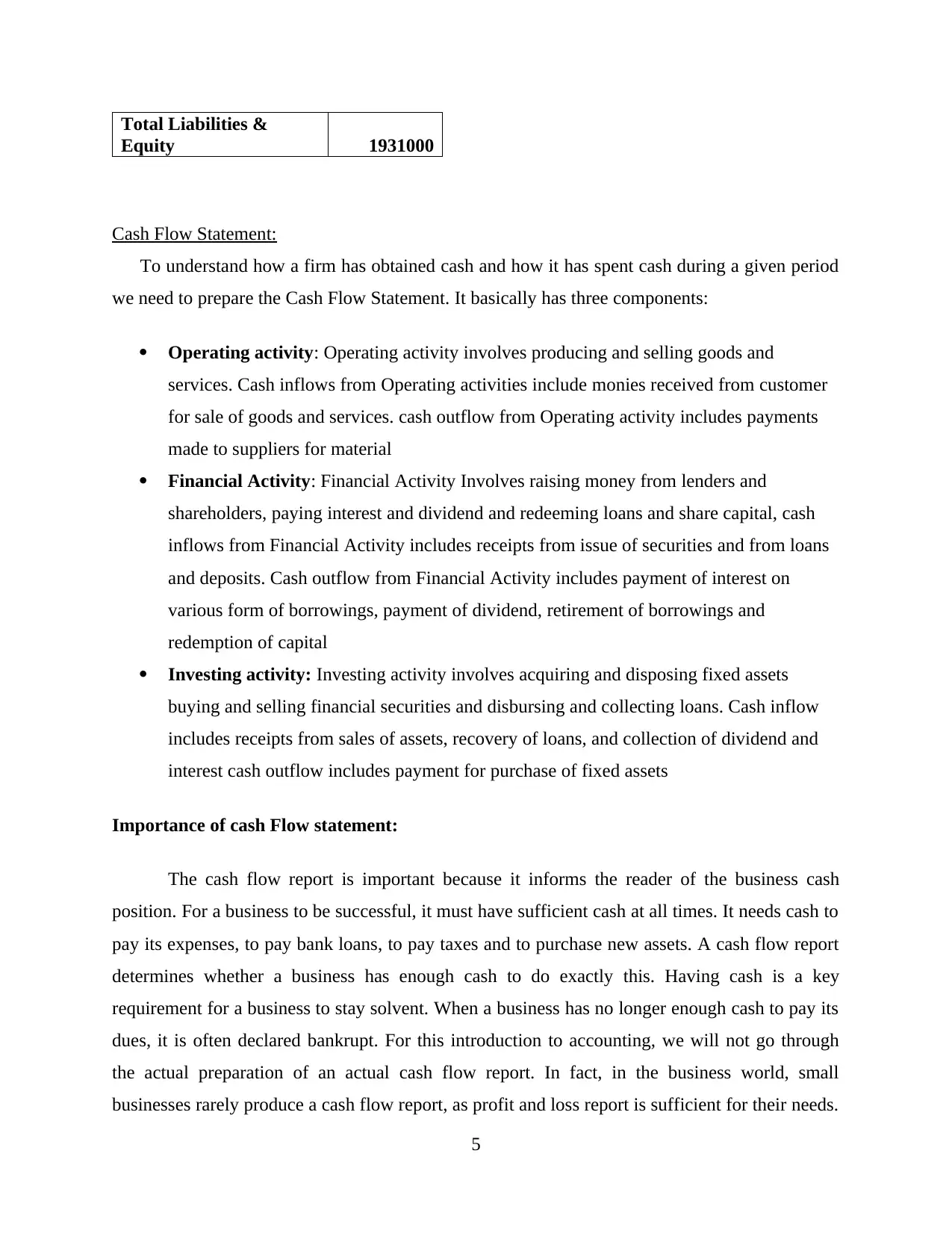
Total Liabilities &
Equity 1931000
Cash Flow Statement:
To understand how a firm has obtained cash and how it has spent cash during a given period
we need to prepare the Cash Flow Statement. It basically has three components:
Operating activity: Operating activity involves producing and selling goods and
services. Cash inflows from Operating activities include monies received from customer
for sale of goods and services. cash outflow from Operating activity includes payments
made to suppliers for material
Financial Activity: Financial Activity Involves raising money from lenders and
shareholders, paying interest and dividend and redeeming loans and share capital, cash
inflows from Financial Activity includes receipts from issue of securities and from loans
and deposits. Cash outflow from Financial Activity includes payment of interest on
various form of borrowings, payment of dividend, retirement of borrowings and
redemption of capital
Investing activity: Investing activity involves acquiring and disposing fixed assets
buying and selling financial securities and disbursing and collecting loans. Cash inflow
includes receipts from sales of assets, recovery of loans, and collection of dividend and
interest cash outflow includes payment for purchase of fixed assets
Importance of cash Flow statement:
The cash flow report is important because it informs the reader of the business cash
position. For a business to be successful, it must have sufficient cash at all times. It needs cash to
pay its expenses, to pay bank loans, to pay taxes and to purchase new assets. A cash flow report
determines whether a business has enough cash to do exactly this. Having cash is a key
requirement for a business to stay solvent. When a business has no longer enough cash to pay its
dues, it is often declared bankrupt. For this introduction to accounting, we will not go through
the actual preparation of an actual cash flow report. In fact, in the business world, small
businesses rarely produce a cash flow report, as profit and loss report is sufficient for their needs.
5
Equity 1931000
Cash Flow Statement:
To understand how a firm has obtained cash and how it has spent cash during a given period
we need to prepare the Cash Flow Statement. It basically has three components:
Operating activity: Operating activity involves producing and selling goods and
services. Cash inflows from Operating activities include monies received from customer
for sale of goods and services. cash outflow from Operating activity includes payments
made to suppliers for material
Financial Activity: Financial Activity Involves raising money from lenders and
shareholders, paying interest and dividend and redeeming loans and share capital, cash
inflows from Financial Activity includes receipts from issue of securities and from loans
and deposits. Cash outflow from Financial Activity includes payment of interest on
various form of borrowings, payment of dividend, retirement of borrowings and
redemption of capital
Investing activity: Investing activity involves acquiring and disposing fixed assets
buying and selling financial securities and disbursing and collecting loans. Cash inflow
includes receipts from sales of assets, recovery of loans, and collection of dividend and
interest cash outflow includes payment for purchase of fixed assets
Importance of cash Flow statement:
The cash flow report is important because it informs the reader of the business cash
position. For a business to be successful, it must have sufficient cash at all times. It needs cash to
pay its expenses, to pay bank loans, to pay taxes and to purchase new assets. A cash flow report
determines whether a business has enough cash to do exactly this. Having cash is a key
requirement for a business to stay solvent. When a business has no longer enough cash to pay its
dues, it is often declared bankrupt. For this introduction to accounting, we will not go through
the actual preparation of an actual cash flow report. In fact, in the business world, small
businesses rarely produce a cash flow report, as profit and loss report is sufficient for their needs.
5
Paraphrase This Document
Need a fresh take? Get an instant paraphrase of this document with our AI Paraphraser
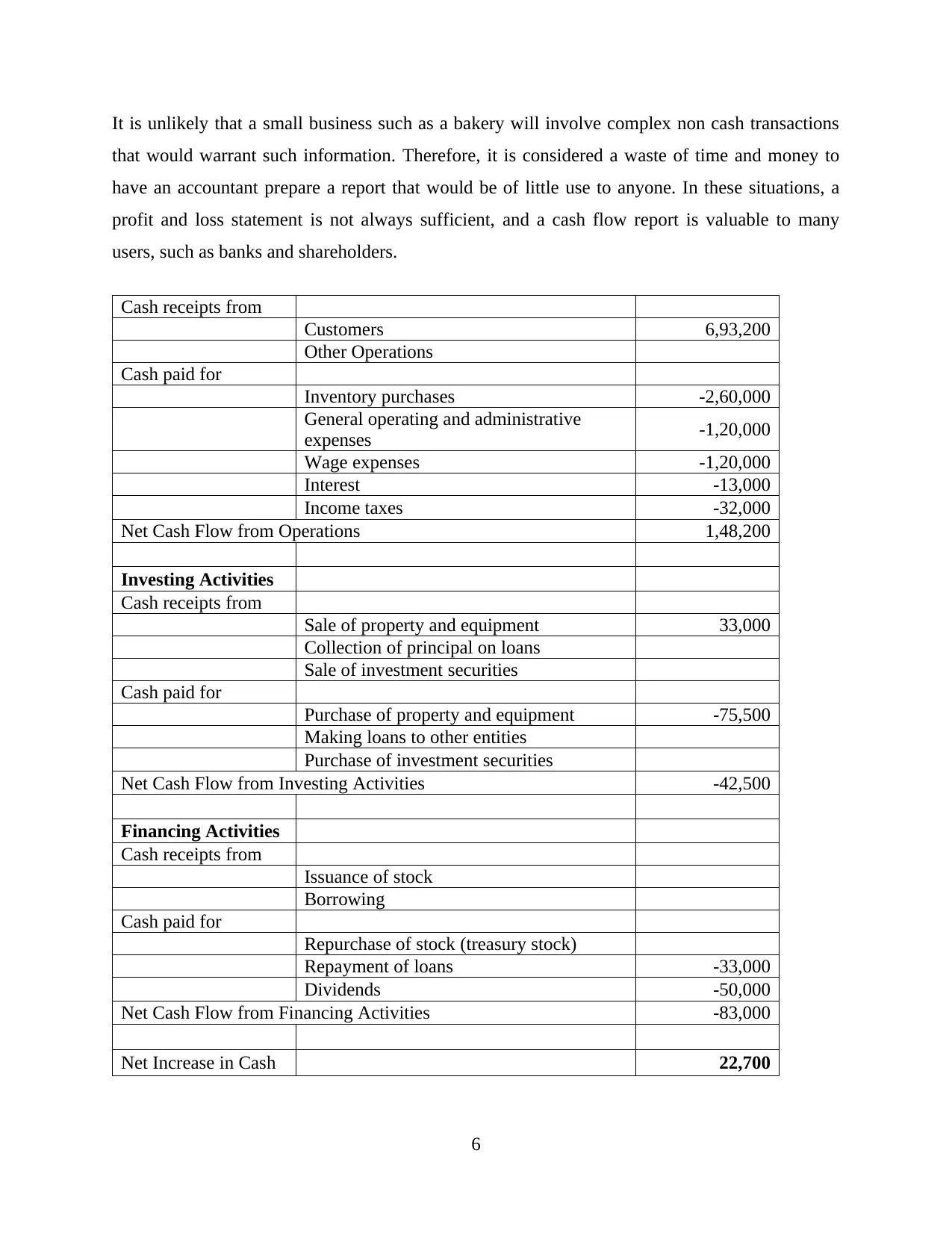
It is unlikely that a small business such as a bakery will involve complex non cash transactions
that would warrant such information. Therefore, it is considered a waste of time and money to
have an accountant prepare a report that would be of little use to anyone. In these situations, a
profit and loss statement is not always sufficient, and a cash flow report is valuable to many
users, such as banks and shareholders.
Cash receipts from
Customers 6,93,200
Other Operations
Cash paid for
Inventory purchases -2,60,000
General operating and administrative
expenses -1,20,000
Wage expenses -1,20,000
Interest -13,000
Income taxes -32,000
Net Cash Flow from Operations 1,48,200
Investing Activities
Cash receipts from
Sale of property and equipment 33,000
Collection of principal on loans
Sale of investment securities
Cash paid for
Purchase of property and equipment -75,500
Making loans to other entities
Purchase of investment securities
Net Cash Flow from Investing Activities -42,500
Financing Activities
Cash receipts from
Issuance of stock
Borrowing
Cash paid for
Repurchase of stock (treasury stock)
Repayment of loans -33,000
Dividends -50,000
Net Cash Flow from Financing Activities -83,000
Net Increase in Cash 22,700
6
that would warrant such information. Therefore, it is considered a waste of time and money to
have an accountant prepare a report that would be of little use to anyone. In these situations, a
profit and loss statement is not always sufficient, and a cash flow report is valuable to many
users, such as banks and shareholders.
Cash receipts from
Customers 6,93,200
Other Operations
Cash paid for
Inventory purchases -2,60,000
General operating and administrative
expenses -1,20,000
Wage expenses -1,20,000
Interest -13,000
Income taxes -32,000
Net Cash Flow from Operations 1,48,200
Investing Activities
Cash receipts from
Sale of property and equipment 33,000
Collection of principal on loans
Sale of investment securities
Cash paid for
Purchase of property and equipment -75,500
Making loans to other entities
Purchase of investment securities
Net Cash Flow from Investing Activities -42,500
Financing Activities
Cash receipts from
Issuance of stock
Borrowing
Cash paid for
Repurchase of stock (treasury stock)
Repayment of loans -33,000
Dividends -50,000
Net Cash Flow from Financing Activities -83,000
Net Increase in Cash 22,700
6

7
⊘ This is a preview!⊘
Do you want full access?
Subscribe today to unlock all pages.

Trusted by 1+ million students worldwide
1 out of 9
Related Documents
Your All-in-One AI-Powered Toolkit for Academic Success.
+13062052269
info@desklib.com
Available 24*7 on WhatsApp / Email
![[object Object]](/_next/static/media/star-bottom.7253800d.svg)
Unlock your academic potential
Copyright © 2020–2025 A2Z Services. All Rights Reserved. Developed and managed by ZUCOL.





